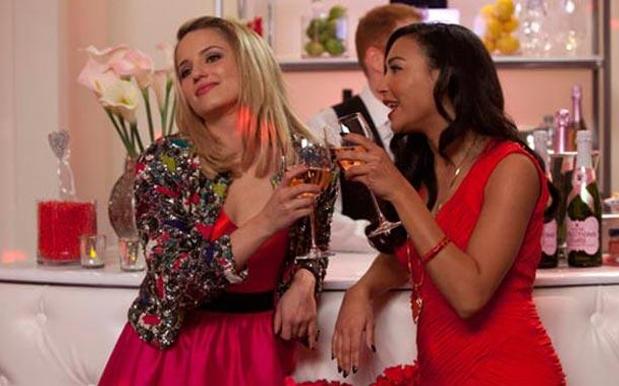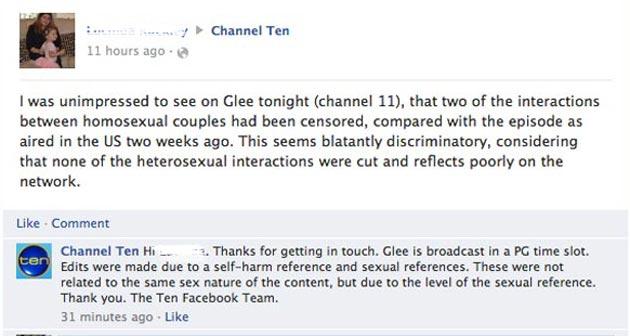
The episode of Glee that aired on Channel Ten‘s offshoot Eleven last night, titled “I Do”, was not screened as it was originally intended. Scenes containing interactions between same-sex couples on the show had been removed from the Ten broadcast – a detail that was picked up by a particularly meticulous viewer of the show who subsequently noted the omission of content on Ten’s Facebook page:
The commenter wrote:
“I was unimpressed to see on Glee tonight (channel 11), that two of the interactions between homosexual couples had been censored, compared with the episode as aired in the US two weeks ago. This seems blatantly discriminatory, considering that none of the heterosexual interactions were cut and reflects poorly on the network.”
Glee is a veritable fairground for people with appreciation for a certain style of entertainment. A style that includes high-production musical numbers, costumes the colours of an Easter parade, modern dance specialists named ‘Brittany’, and a favourable view toward over-acting. Ergo, its target audience is me, children under 14 and anyone who appreciates quality drag performance.
Glee co-creator Ryan Murphy regularly makes reference to the show’s overarching theme of inclusiveness and individuality (big positive words that also represent underdogs and outsiders). The show’s story arcs have tackled subjects like disability (physical and intellectual), race, adoption, abandonment, abortion, depression, substance abuse, and teenage sexuality covering gay males, lesbians, bisexuality, and teenage drag queens.
Glee‘s gay following provides a significant chunk of its dedicated audience (for attributes like those mentioned in the reductive stereotyping listed above) and because the show has been groundbreaking in its depiction of open LGBT characters. On the flipside Glee has been criticised by some who accuse the show of reinforcing gay stereotypes, while other critics accuse the show of a “gay bias” an abstract term meaning that LGBT characters are represented extremely favourably on the show, yet the screen time of same-sex physical contact is nowhere near comparable to that between hetero couples.
The LGBT content in Glee is not exactly breaking news today (Brett Berk of Vanity Fair writes a (wildly non-PC) regular column titled “The Gay Guide To Glee”) nor is it considered especially shocking television (remember: Glee is a comedy geared to high school teens, after all), so why would Ten remove that kind of content?
This is the response from Channel Ten:
The explanation rang a little hollow, so we got in touch with a Network Ten Spokesperson this morning to get more information. They told us the content of the episode was modified in order to stay within the guidelines of the Commercial Television Industry Code of Practice, the body responsible for regulating all material broadcast on commercial free-to-air television. The Ten spokesperson also said that neither the Code nor Network Ten discriminates on the basis of same-sex relationships.
According to the classification guidelines the “visual depiction of and verbal reference to sexual activity must be restrained, mild in impact and justified by the story line or program context” for all shows that are rated PG, and according to the network spokesperson the level of sexual reference removed from the episode was outside the classification requirements for programs that are rated PG (like Glee).
These are the deleted scenes [helpfully located by TV Tonight]. The first features a scene between Kurt and Blaine in which a sexual encounter is implied; the second has a scene featuring Santana and Quinn in which sex is also implied.
Under the aforementioned Code, programs broadcast between 7.30pm to 8.30pm like Glee can’t have a stronger classification than PG. Material classified PG may contain “careful presentations of adult themes or concepts, but must be mild in impact and remain suitable for children to watch with supervision”.
So: is it unsuitable for a PG audience?
In the clips you can see that the sex isn’t explicit, merely implied via the usual cues (falling through hotel room door, buttoning up shirt the next day/lying in bed naked talking about experimentation, and careful substitutions of words like “it”, “this” and “experiment” instead of saying s-e-x). [PS This is entirely beside the point, but don’t you think the patronising treatment of poor pathetic fag hag is annoyingly brutal? And who uses the term “hag” in actual life anyway?] The real question here is: would the same scenes be removed if heterosexual couples were depicted in them?
The movie Grease is regularly programmed during prime hours and is quite graphic in its sexual content (such as the back-of-the-car scene with Rizzo and Kenickie, and Kenickie’s “25 cents insurance policy” “breaks”). How can the content of it be shown and not those scenes above? It’s not that I have a problem with Grease at all, quite the contrary, but it is noticeably absent of any inferences to gay sex – implied or otherwise.
Regarding the second part of the Facebook response about self harm, the Ten spokesperson told us that the “visual depiction of and verbal reference to suicide or attempted suicide must be inexplicit and restrained, and be mild in impact. It must not be presented as the means of achieving a desired result or as an appropriate response to stress, depression or other problems.” Unless they are making a super-abstract inference regarding the fucked equilibrium of Mr Schuester and Emma’s psyches following their marriage Fail, we failed to pick up on a reference to suicide or attempted suicide. When I asked Ten to detail what moment or scene they were referring to I was told “Network Ten took the necessary precautions to ensure last night’s episode of Glee adhered to The Code requirements for a programs complying with a PG classification category.”
Right then.
It’s hard to gauge what does and does not constitute appropriate content for children (because I’m not a parent) but, from what I can see, the concept of ‘sex’ is still fairly taboo on primetime television – particularly for those without cable or torrent-acquired access to the clothing-optional canon of HBO. An attitude toward sex and its depiction on television as mind-fouling red flag territory seems old hat nowadays (quite like the term ‘nowadays’ or ‘old hat’) and it’s time for the Commercial Television Industry Code of Practice to be appraised.
The Code has been registered with the Australian Communications and Media Authority (ACMA) and has been formulated after extensive consultation with government advisory bodies, community interest groups and the public generally, and it’s the body that sets out the requirements for programs to comply with a particular classification category and the times at which different types of programs and promotions may be broadcast. Putting sexual preference aside for a moment, what does this incidence of censorship say about the ACMA?
Is the ACMA regulations to blame for the Glee scenes being edited or do you think the onus falls on Network Ten in this instance? I can’t answer that but I encourage you to share your feelings and opinions in the comment section.



